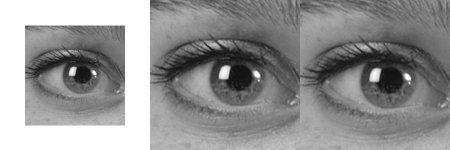jlw
Rangefinder camera pedant
One of the stated features of Epson's PhotoRaw 1.21 (now available for download from European Epson sites, but not yet from Epson USA as far as I know) is that it can interpolate the R-D 1's 6-megapixel raw files to a larger size -- 3000 pixels wide rather than 2000. Epson claims that its special technique produces a sharper-looking result than regular bicubic interpolation as used in Adobe Photoshop.
I've got the 1.21 download and decided to test this. I've attached a simple comparison frame (saved as maximum-quality JPEG) so you can see the results for yourself.
The test images were crops of one eye from a headshot (full frame version at reduced size attached separately.) In the comparison image, the original uninterpolated eye is shown at left, then the two versions enlarged with PhotoRaw and Photoshop.
But just for fun, I'm NOT going to tell you which is which! I'm interested in seeing whether anyone can actually see a difference in a "blind" comparison. So, post your picks and we'll see how we do!
I've got the 1.21 download and decided to test this. I've attached a simple comparison frame (saved as maximum-quality JPEG) so you can see the results for yourself.
The test images were crops of one eye from a headshot (full frame version at reduced size attached separately.) In the comparison image, the original uninterpolated eye is shown at left, then the two versions enlarged with PhotoRaw and Photoshop.
But just for fun, I'm NOT going to tell you which is which! I'm interested in seeing whether anyone can actually see a difference in a "blind" comparison. So, post your picks and we'll see how we do!



